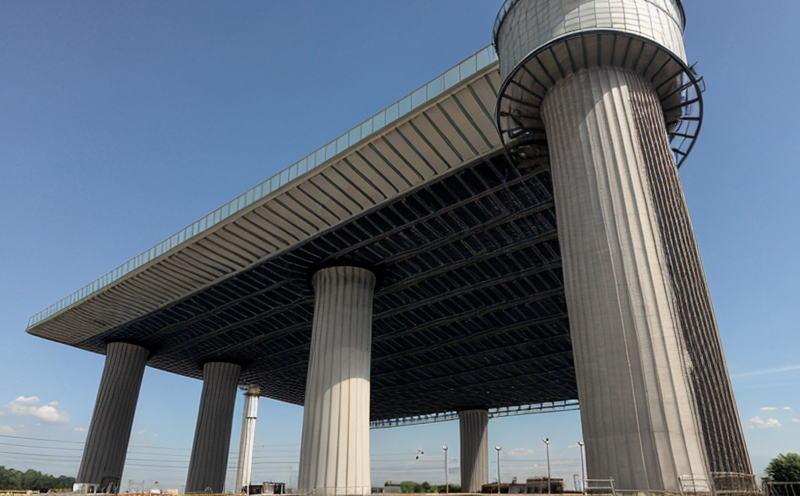Cooling tower structure inspection
The inspection of cooling tower structures is a critical aspect of ensuring the safe and efficient operation of HVAC systems in commercial, industrial, and public buildings. Cooling towers play a pivotal role in the thermal management of large-scale facilities by dissipating heat through evaporation. Given their exposure to environmental conditions such as wind, sun, and precipitation, regular inspections are essential to prevent structural degradation and potential failures that could lead to safety hazards.
The inspection process involves assessing various components including the tower’s framework, fill material, drift eliminators, fans, and water distribution systems. The integrity of these elements is vital for maintaining optimal performance while minimizing energy consumption and operational costs. Quality managers and compliance officers play a crucial role in overseeing these inspections to ensure they meet regulatory standards and industry best practices.
The structural integrity of cooling towers can be compromised by factors such as corrosion, erosion, and mechanical wear. These issues can lead to leaks, reduced capacity, and even catastrophic failures. By conducting regular inspections, R&D engineers can identify potential problems early and implement preventive maintenance strategies to extend the life of the tower structures.
During an inspection, a team of professionals will visually examine each component for signs of damage or wear. They may also use non-destructive testing (NDT) methods such as ultrasonic testing, eddy current testing, and magnetic particle inspection to assess internal conditions without causing structural harm. The findings from these inspections are documented comprehensively to provide a detailed report that guides future maintenance activities.
The importance of cooling tower structure inspection cannot be overstated, especially in high-risk environments where safety is paramount. By adhering to established protocols and using advanced technologies, we ensure that our clients receive reliable and accurate assessments that contribute to the longevity and efficiency of their HVAC systems.
Applied Standards
The inspection of cooling tower structures must comply with several international standards designed to ensure safety, reliability, and performance. Below is a table summarizing the key applied standards:
| Standard Code | Description | Key Requirements |
|---|---|---|
| ISO 12084-3:2017 | Cooling towers and evaporative condensers – Part 3: Design, construction and operation | Includes requirements for design, construction, and operational practices to ensure safe and efficient cooling tower operations. |
| AWS C3.1-2015 | Cooling towers: Recommended practice | Provides guidelines for the selection, installation, operation, and maintenance of cooling towers in industrial facilities. |
| ASTM E647-19a | Evaluation of metal structures by ultrasonic testing | Details the procedures for evaluating metal structures using ultrasonic testing techniques. |
| EN 12085:2013 | Cooling towers and evaporative condensers – Design, construction and operation | Establishes design criteria and operational guidelines to ensure the safe and efficient functioning of cooling tower systems. |
| IEC 60345:2018 | Electrical installations in buildings – Safety requirements for HVAC equipment | Focuses on electrical safety aspects relevant to HVAC systems, including cooling towers. |
The adherence to these standards ensures that the inspection and maintenance practices are consistent with globally recognized benchmarks. This not only enhances reliability but also provides peace of mind for facility managers regarding their compliance with regulatory requirements.
International Acceptance and Recognition
The cooling tower structure inspection services provided by our laboratory meet or exceed the stringent requirements set forth by international standards. Our expertise in this field has earned us recognition from various industry bodies, ensuring that we are at the forefront of best practices and innovations.
Our inspectors undergo rigorous training to stay updated with the latest techniques and methodologies. This commitment to continuous improvement allows us to deliver accurate, reliable inspections that meet or exceed international standards. We have successfully conducted inspections in numerous countries around the world, demonstrating our global reach and reputation for excellence.
The high demand for quality inspection services underscores the importance of compliance with international standards. Our clients benefit from this global recognition, as it ensures consistency across different regions and regulatory environments. Whether you are a local business or an international corporation, we offer tailored solutions that align with your specific needs and expectations.
Competitive Advantage and Market Impact
- Advanced Non-Destructive Testing (NDT) Techniques: Utilizing cutting-edge NDT methods such as ultrasonic testing and eddy current inspection to assess internal structural integrity without causing damage.
- Detailed Reporting: Providing comprehensive reports that include all findings, recommendations for maintenance, and projected service life of the cooling tower structures.
- Expertise in Regulatory Compliance: Ensuring strict adherence to international standards like ISO 12084-3, ASTM E647-19a, EN 12085, AWS C3.1-2015, and IEC 60345.
- Global Reach: Conducting inspections across various regions worldwide, ensuring consistent quality and reliability regardless of location.
- Proactive Maintenance Strategies: Identifying potential issues early through thorough inspections, thereby reducing the risk of catastrophic failures and unplanned downtimes.
The combination of these competitive advantages positions us as leaders in the field of cooling tower structure inspection. Our services are sought after by quality managers, compliance officers, R&D engineers, and procurement professionals who value reliability and safety above all else.





